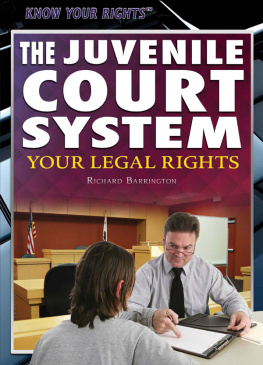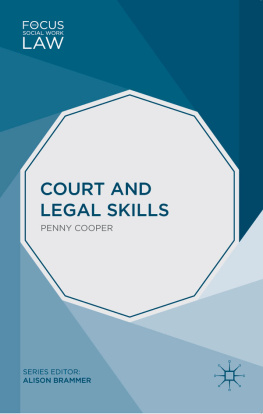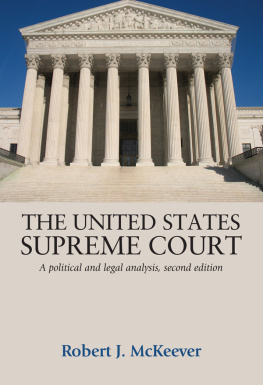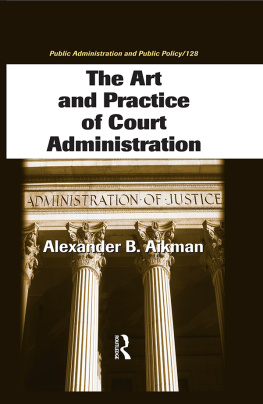First published 1969 by Transaction Publishers
Published 2017 by Routledge
2 Park Square, Milton Park, Abingdon, Oxon 0X14 4RN
711 Third Avenue, New York, NY 10017, USA
Routledge is an imprint of the Taylor & Francis Group, an informa business
Copyright 1969 by Robert M. Emerson
All rights reserved. No part of this book may be reprinted or reproduced or utilised in any form or by any electronic, mechanical, or other means, now known or hereafter invented, including photocopying and recording, or in any information storage or retrieval system, without permission in writing from the publishers.
Notice:
Product or corporate names may be trademarks or registered trademarks, and are used only for identification and explanation without intent to infringe.
Library of Congress Catalog Number: 2007031523
Library of Congress Cataloging-in-Publication Data
Emerson, Robert M.
Judging delinquents : context and process in juvenile court / Robert M. Emerson.1st pbk. ed.
p. cm.
Includes bibliographical references and index.
ISBN 978-0-202-36163-5
1. Juvenile courtsUnited States. I. Title.
KF9709.E44 2007
345.73'081--dc22
2007031523
ISBN 13: 978-0-7658-0836-3 (pbk)
For PamPreface
The juvenile court has elicited the interest and criticism of lawyers, social workers, and criminologists, but has received relatively little attention from sociologists. This seems to reflect a more general shortcoming of sociologya paucity of research on legal institutions. Fortunately, recent studies have begun to rectify this situation (e.g., Blumberg, 1967; Cicourel, 1968; Skolnick, 1966) . This book seeks to add to this growing sociological literature on the operations of legal institutions. It describes some critical aspects of the functioning of the juvenile court, an institution charged with judging and treating delinquents. To this end, it analyzes the nature of the court operation, the handling of delinquents, and the court's functions in relation to the wider social and legal system.
This study reflects two distinct sociological heritages. First, it presents an institutional analysis of a juvenile court. One basic component of such an analysis involves description of the social context within which the juvenile court functions. In this way this book considers the nature of the court's relations with the various local institutions in its working environment and the consequences of these relations for its internal operations.
But in addition, the juvenile court movement has historically been associated with the introduction of rehabilitative programs into the punitively tempered criminal law. And to this day, the juvenile court represents one of the major areas of involvement for such helping professionals as social workers and psychiatrists in the criminal law. These features provide the second focal point for institutional analysisthe conflicting ideologies and purposes built into the court and the ways in which they are resolved and worked out in the practical matter of judging and dealing with delinquents.
Second, this study grows out of the current societal reaction approach to deviance (e.g., Becker, 1963; Kitsuse, 1964). This approach views deviance as the product of the response of official agents of social control to perceived norm violations: "deviance" involves acts and actors reacted to and labeled as such, usually by these officials. In line with this general perspective, this study seeks to shed light on some of the processes by which youths come to be identified and officially labeled "delinquents."
The following analysis attempts to combine the institutional and societal reaction approaches. This means that it is concerned with the ways in which the juvenile court's judgments and responses to the troublesome and disturbing behavior of youths are influenced by the external context and internal dynamics of the court operation.
However, it is necessary to emphasize the limited sense in which this is a study of labeling reactions to delinquents. The juvenile court represents but one of several "screenings" through which a youth must pass before he comes to see himself, and to be seen by others, as a "delinquent." This study does not directly analyze screening stages prior or subsequent to court involvement. Prior stages are considered only to the extent that decisions made there act as constraints on the court process itself. Hence the practices and decisions of the police and other enforcers in selecting cases for court action are considered only insofar as they influence the court's handling of these cases. Furthermore, although this study analyzes how the court responds differentially to cases judged to be of different kinds, it does not consider the consequences of such differential court action ("labels") for the youth involved beyond the court itself. Instead, it highlights the juvenile court's distinctive role in the labeling process, particularly in reviewing judgments and decisions made earlier and in changing the legal and social status of those accused of wrongdoing.
In sum, this study focuses on how a particular legal institution defines, reacts to and deals with the cases brought to its attention, whatever the inherent biases of this sample and whatever the ultimate consequences for youths so handled. It describes the processes that produce differential case outcomesoutcomes whereby some delinquents emerge from their court encounter firmly identified as future criminals, while others escape unharmed, not regarded as "really" delinquent despite the formal adjudication to this effect.
This book is based on research conducted at a juvenile court in a large metropolitan area. Field work began at the end of January 1966, continued on an almost daily basis through July of that year, and resumed at a less intensive level from September 1966 through May 1967. The technique of participant observation was complemented by informal interviews with court staff, usually focused on problems connected with cases that had been observed previously. After initial observation of the various phases of court activity, research centered on the progress of individual cases through the stages of court processing. Cases were followed from the preliminary complaint in the clerk's office, during initial and subsequent handling by probation staff, and finally throughout the courtroom proceeding.
At all stages of field work, special effort was made to observe interaction between delinquents and court officials. Particular attention was devoted to two settingsformal courtroom proceedings and more informal encounters between probation officers and delinquents and their families. Significantly, observation of the latter was facilitated by the lack of privacy characteristic of probation operations at the court: all probation interviews were conducted in one of three large, unpartitioned offices shared by three to four probation officers. Privacy was almost unattainable, and probation interviews, routinely held in this open setting, ordinarily allowed direct and easy access.
Furthermore, regular attempts were made to elicit judgments and expectations related to case dispositions. Court staff were continually probed about their analysis of particular cases and the problems that each presented. Probation officers were often asked what outcome they wanted and/or expected, as well as what they thought of particular delinquents and their offenses. Police officers, truant officers, Child Welfare Department workers, and others with some official standing in cases were approached informally wherever possible with questions about background and outlook. Here acquaintanceship with the probation staff often provided a means of establishing quick rapport. Finally, on many occasions informal discussions were held with judges shortly after the morning's sessions. Explicit statements about the grounds for decisions, factors that had been considered, and perceptions of the problems presented by cases were sought. Many afternoons were spent sitting around probation offices sharing in gossip about the day's cases and about delinquents, lawyers, criminals, courts, and probation work in general.









